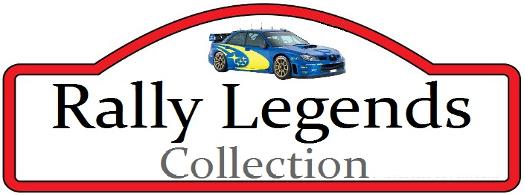
1978 Lancia Sratos HF Tipo 829
The original concept car, the Lancia Stratos Zero, was shown at the Turin motor show of 1970 but the car that hit the Rally circuit was rather a different beast.
The Rally Stratos’ was a radical design which stood just over three and a half feet tall and with stunning looks (and visibility) courtesy of the wraparound windscreen it, captured the heart of Cesare Fiorio, manager of Lancia’s World Rally Championship team. His plan for the Stratos was simply to dominate world rallying. The Stratos was hoped to be a match, or better, for the Porsche 911s and Renault-Alpines and it more than lived up to expectations. Cesare Fiorio was supported in his ambitions to get the Stratos into competition by Mike Parkes, an engineer and race driver, factory rally driver Sandro Munari and Bertone's Designer Marcello Gandini. Bertone developed the body work further and it is still as stunning today as it was back in the 1970s.
Powered by a Ferrari Dino 2.4-litre V-6 engine placed a mid ships the machine had a 0–60 time of less than 5sec's. In naturally aspirated production form the engine turned out 192 hp, for racing it could be tuned up to 280 hp. As an aside Enzo Ferrari didn't actually want Lancia to benefit from his engines and had some difficult meetings with the FIAT group management. Just as Lancia was about to fit one of their own engines the "Commendatore" relented and 500 engines were delivered to the Lancia plant. Drive went through a five-speed gearbox the rear wheels and the rally version could reach a top speed of 232 km/h (144 mph), depending on the gearing of course.
Production started in 1973 with Bertone manufacturing the Stratos bodyshells in Turin before sending the cars over to Lancia’s Chivasso factory for final assembly. The short wheelbase Stratos was incredibly quick, if a little ‘twitchy’ under acceleration and prone to let loose at the back. It's maneuverability allowed the experienced drivers to place the Stratos easily and precisely anywhere on the road. In short it was the perfect tool to dominate international rally competition, and that's just what it did. The Stratos took it's first rally win in 1973 in the prototype class.
To move on from the prototype class and participate in the 1974 Group 4 rally championship Lancia's cars needed to be homologated; and in order to receive homologation Lancia needed to make at least 500 road going cars. This was a bit of an issue as in total only 492 Lancia Stratos HF Stradale cars were built. When the Group 4 production requirement for the WRC was suddenly dropped to 400 units Lancia was in business. With homologation secured and cars storming to victory in rally after rally the Stratos was on sale to it's devotees at the height of its success.
Sandro Munari and Björn Waldegård drove the Stratos to World Rally Championship victory in 1975, '76 and '77 despite the 24 valve heads having been banned from competition for being non-standard at the beginning with the 1976 season. The power loss wasn't as big a disability as was first though and when it didn't crash, or suffer premature transmission failure, the Stratos remained the car to beat. Then Fiat group's internal politics hit the Stratos as the responsibility for the companies rallying program was passed to the Fiat 131 Abarths. But on the Rally front the Stratos was far from dead and carried on winning in private hands.
The Stratos also won the 1974 Targa Florio driven by Gerard Larrousse. Lancia were so dominant in rallying that by the mid 1970s thoughts were turning to Group5 circuit racing and the 'Silhouette' series so two Group 5 racing cars built with the KKK turbocharger, these cars competed in the Giro d'Italia and Japanese Group 5 championship.
Christine Dacremont and Lella Lombardi drove a Stratos to 20th place in the 1976 24 Hours of Le Mans and Bernard Darniche gave the Stratos it's last victory when he took the 1981 'Tour de course Automobile'.
Rallye Sanremo 1978
The "Rallye Internazionale di Sanremo" inspired by Rallye Automobile Monte Carlo and this is also the reason for the adoption of the French spelling of Rally. First held in 1928 the event had a sporadic continuity until 1961 after which it has been a yearly event and featured in the WRC and Manufacturers Championship.
The 1978 San Remo Rally was the 8th round of the WRC constructors championship and the 13th round of the FIA rally drivers cup. It was predominantly an asphalt rally with a length of 893,80km held over the 3rd to the 7th of October 1978.
Lancia had done little if any development work on the Stratos since the ban on 24valve heads and 1978 was to be the Stratos' last year as a works car, Fiat having swapped to the Abarth Fiat 131. This meant that the works team were entering two marques in the 1978 Sanramo, Walter Rohrl and Sanro Munari had the Arbarth 131s and Alen was put into Rohrl's Stratos now running in Pirelli colours as the Alitalia sponsorship was swapped to the 131s.
The winners were Markku Alén and Ilkka Kivimäki in their Stratos HF carrying #4 on the door. The winning average speed was 81.4kph. Rohrl and Munari both crashed out!
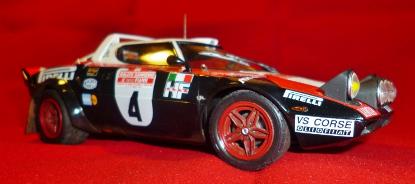



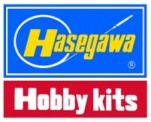
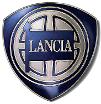
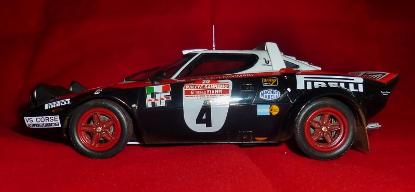



Lancia Stratos HF 1978 San Remo Rally winner Hasegawa kit # 20218
Hasegawa and Revell collaborated on the original Alitalia liveried release back in 2002 which was quickly followed up by two other 2002 releases in alternative liveries. The same kit has been re-released multiple times with additional parts and later colour schemes making this a very adaptable kit, there is even a road going Stradale version which is particularly fetching.
A multitude of aftermarket detail sets include a very nice engine upgrade set, by Reji Model, and the breadth of decal sets is breath taking allowing almost all the winning Stratos cars can be modelled.
The kit is one of the best car kits on the market. All the parts fit well and the process of building is intelligent. The only problem area is actually getting the chassis into the body which must be flexed quite a lot to get the chassis in. This is due to the shape of the car itself not anything to do with the kit engineering.
Our thanks to Jim Maher for donating this kit to the Museum.
Our model was built more or less straight from the box in March 2016. It was enhanced with seatbelts from HGW and p.e. hood pins from ........ The windscreen wiper is an amalgam of the kit arm and a photo etch blade. Other details came from generic sets from S&S Specialties and Marshall Autos although both those firms are now out of production there are other firms that do similar generic sets for shapes and windscreen wipers.
Alclad II black and white primers was airbrushed on for the base coat with Plamo UK black and Zero paints brilliant white lacquer based paints for the main body colours. The red stripe decals were applied and then the whole body covered with Plamo UK Gloss clear lacquer tor the top coat. This was then gently sanded smooth and polished with "Tcut". Other paints used were Humbrol enamels, Games Workshop Citadel acrylic paints and ink washes and Tamiya clear red and orange.
With a good gloss finish the decals were applied, but they were very fragile (possibly due to age) and broke up making it hard to press them down flat. Due to this issue all the decals were covered with John's Klear floor polish. Alclad II acrylic gloss would also do the same job.
RETURN TO :-
